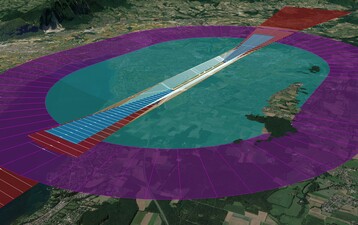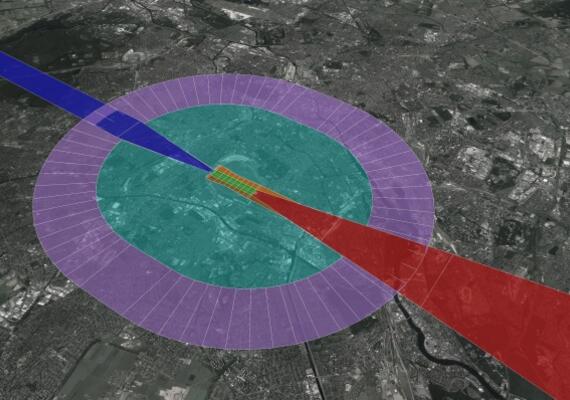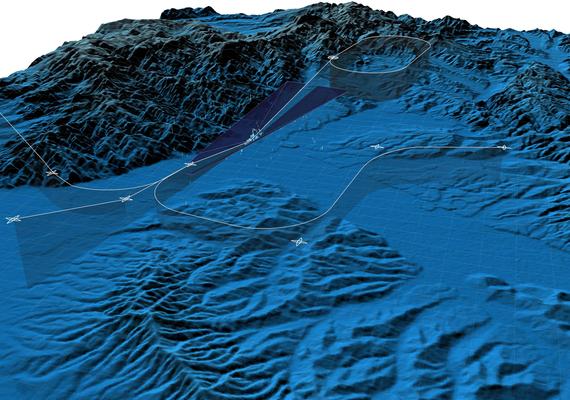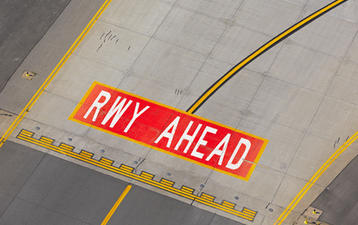NEU
Obstacle Limitation Surfaces (OLS): Einführung in aktuelle und zukünftige Hindernisbegrenzungsflächen
*Übersetzung folgt*
Safe airport operations demand a permanent monitoring of obstacles in the close proximity of airports. The construction of new infrastructure or changes to airport operations require systematic obstacle evaluations and assessments to maintain an acceptable level of safety.
International regulations from the International Civil Aviation Organization (ICAO) as described in Annex 14 Vol. I specify airspace around aerodromes to be maintained free from obstacles. For that purpose, Obstacle Limitation Surface (OLS) are described.
Nevertheless, history shows that the OLS become penetrated by new obstacles world-wide, and it becomes more difficult to protect the surfaces against new obstructions. The reasons are manifold and include unclear objectives of the OLS, inconsistencies between ICAO Annex 14, Annex 6, and PANS OPS requirements as well as unclear adequacy between the obstacle requirements of the surfaces and the complex impact of obstacles on the operations.
To address the deficiencies of the current OLS, the ICAO intends to revise the OLS. Over the last years, the ICAO Obstacle Limitation Surfaces Task Force (OLSTF) developed a new twofold concept of Obstacle Free Surfaces (OFS) and Obstacle Evaluation Surfaces (OES). Furthermore, a new code systematic, the aeroplane design groups (ADG), for the design of the OFS and OES is foreseen.
The objective of this training course is to provide a comprehensive overview of both, the current Obstacle Limitation Surface (OLS) as described in ICAO Annex 14 Vol. 1 as well as of the foreseen new surfaces. The new concept, ADG as well as the OFS and OES are presented.
Attendees will learn how to establish the relevant Obstacle Limitation Surfaces (OLS, OFS, OES) and how to determine surface infringements.
This three-day course is designed for all persons involved in this complex subject, including aerodrome, Civil Aviation Authority personnel, or project developers.
Please note: This course aims to present the principles and characteristics of the relevant Obstacle Limitation Surfaces (OLS, OFS, OES). To learn more about how to assess relevant Obstacle Limitation Surfaces, to evaluate the significance of penetrating obstacles and to develop appropriate safety measures where necessary, airsight offers another training course.
Kursinfo
Ort:In-houseSprache:Englisch
Dauer:3 Tage
Anbieter:airsight GmbH
Inhalt
Regulations and Fundamentals
- International Civil Aviation Organisation (ICAO)
- Categories of aircraft, aerodromes and runways
ICAO Obstacle Limitation Surfaces (OLS)
- Horizontal and Conical surfaces
- Approach surface
- Transitional surface
- Take-off climb surface
- Obstacle Free Zone (OFZ)
Aerodrome Areas and further obstacle protection surfaces
- Runway strip
- Runway End Safety Area (RESA)
- Clearway
- PAPI obstacle protection surface
- Light plane
- Visual Segment Surface (VSS)
Foreseen ICAO Obstacle Limitation Surfaces
- Background and the new concept
- New Aeroplane Design Groups (ADG)
- Obstacle Free Surfaces (OFS)
- Obstacle Evaluation Surfaces (OES)
Referenten
Dipl.-Ing. Malte Karger
Herr Karger ist für den Geschäftsbereich “aerodrome safeguarding and flight procedures” der airsight GmbH verantwortlich. Er ist auch ein geschätzter Lehrgangsleiter, der sein Wissen und Erfahrungen mit anderen Experten während regulärer Lehrgänge sowie auf In-House-Schulungen (bspw. in Deutschland, Griechenland, Schweiz und Türkei) teilt.
Als sachverständiger Berater des ICAO Instrument Flight Procedure Panels (IFPP) ist Herr Karger Mitglied der Obstacle Limitation Surfaces Task Force (OLSTF).
Herr Karger erwarb umfangreiche Erfahrungen in internationalen Projekten in den Bereichen Hindernisuntersuchungen und Aeronautical Studies (bspw. für die Flughäfen Berlin, Dubai, Hamburg, Luxembourg, Malta, Nürnberg, Stuttgart und Warschau). Darüber gestaltete er in zahlreichen Projekten vielfältige Instrumentenflugverfahren (bspw. für die Flughäfen Berlin, Cluj, Lošinj, Kaunas, Sibiu und Vilnius sowie für Air Austral und die rumänische Flugsicherung ROMATSA).
Prof. Dr.-Ing. Holger Schulz
Herr Schulz ist einer der beiden Firmengründer der airsight GmbH. Er verfügt über einen Abschluss als Diplomingenieur der Luft- und Raumfahrttechnik. Seine Promotion zur Thematik der satellitengestützten Präzisionsanflugverfahren (GBAS) fand u.a. auch bei der internationalen Zivilluftfahrtbehörde (ICAO) Anerkennung. Seit 2014 lehrt Herr Schulz als Honorarprofessor im Fachgebiet „Flughafenplanung“ an der Fakultät Verkehrs- und Maschinensysteme der Technischen Universität Berlin, für die er bereits seit mehreren Jahren Lehraufgaben zu den Themen „Flughafenplanung“ und „Flugroutenplanung“ wahrnimmt.
Durch umfangreiche Projekt- und Beratungserfahrungen sowie seine Aktivitäten in diversen internationalen Gremien, wie bspw. dem Obstacle Clearance Panel (OCP) der ICAO, dem Technical and Operational Safety Committee (TOSC) sowie der Single European Sky (SES) Steering Group des Airport Council International (ACI), der European Organisation for the Safety of Air Navigation (EUROCONTROL) und der European Aviation Safety Agency (EASA) hat Herr Prof. Dr. Schulz sowohl national als auch international hohes Ansehen erlangt.
Herr Prof. Dr. Schulz ist Berufsflugzeugführer und zertifizierter Luftfahrt-Auditor.
Zielgruppe
- Aerodrome safety experts
- Aerodrome engineers and planners
- Air traffic control staff
- Aviation safety experts
- Architects and civil engineers
- Civil Aviation Authorities staff
Organisatorische Details
airsight bietet diesen Lehrgang auf Anfrage als In-House-Schulung an.
Nach erfolgreicher Kursteilnahme erhalten alle Teilnehmer ein airsight-Zertifikat nach EASA-Trainingsregularien, welches weltweit in der Luftfahrtbranche anerkannt ist.
Über unsere Lehrgänge
Zertifizierte Qualität
airsight verfügt über ein nach ISO 9001 zertifiziertes Qualitätsmanagementsystem, in dessen Mittelpunkt die Maximierung des Kundennutzens steht. Wir arbeiten ständig an Verbesserungen – so auch bei unseren Lehrgängen, die wir auch anhand des Teilnehmerfeedbacks kontinuierlich optimieren.


 Sie wollen 5+ Teilnehmer anmelden? Fragen Sie nach einem In-House-Kurs an Ihrem Standort oder online!
Sie wollen 5+ Teilnehmer anmelden? Fragen Sie nach einem In-House-Kurs an Ihrem Standort oder online!


